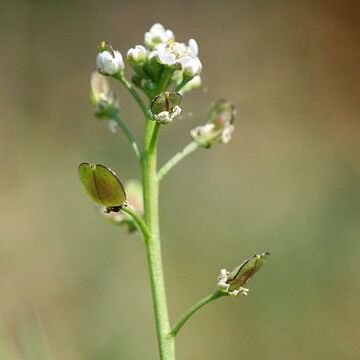Annuals [perennials]; scapose; glabrous or sparsely pubescent. Stems (simple or few to several from base), erect or ascending, unbranched. Leaves basal and cauline; petiolate or sessile; basal (persistent), rosulate, petiolate, blade margins usually lyrate-pinnatifid or pinnatisect, rarely entire or dentate; cauline (0-4), sessile, blade margins entire or dentate. Racemes (corymbose, several-flowered). Fruiting pedicels divaricate, slender. Flowers (actinomorphic or zygomorphic); sepals ascending to spreading, ovate, glabrous; petals white, oblong or obovate, (equal to or longer than sepals, or lateral pair much larger), claw undifferentiated from blade, (apex obtuse); stamens (6) tetradynamous, or (4) equal; filaments dilated basally (appendaged); anthers ovate; nectar glands lateral, 1 on each side of lateral stamen, median glands absent. Fruits (often divaricate), sessile, broadly obcordate to suborbicular, slightly keeled, angustiseptate (strongly compressed), (apex notched); valves prominently veined, (apex narrowly winged), glabrous; replum rounded; septum complete; ovules 4 per ovary; style absent or not; stigma capitate, entire. Seeds uniseriate, slightly compressed, not winged, broadly ovate; seed coat (rugulose), copiously mucilaginous when wetted; cotyledons accumbent. x = 9.
More
Annual herbs. Inflorescence ebracteate. Sepals erect to spreading. Petals dimorphic. Stamens 4 or 6, the filaments appendiculate. Nectariferous glands 4, small, on either side of the lateral stamens, rarely absent. Stigma capitate. Silicula dehiscent, winged, emarginate; septum narrow. Seeds 2 per locule; radicle accumbent.


